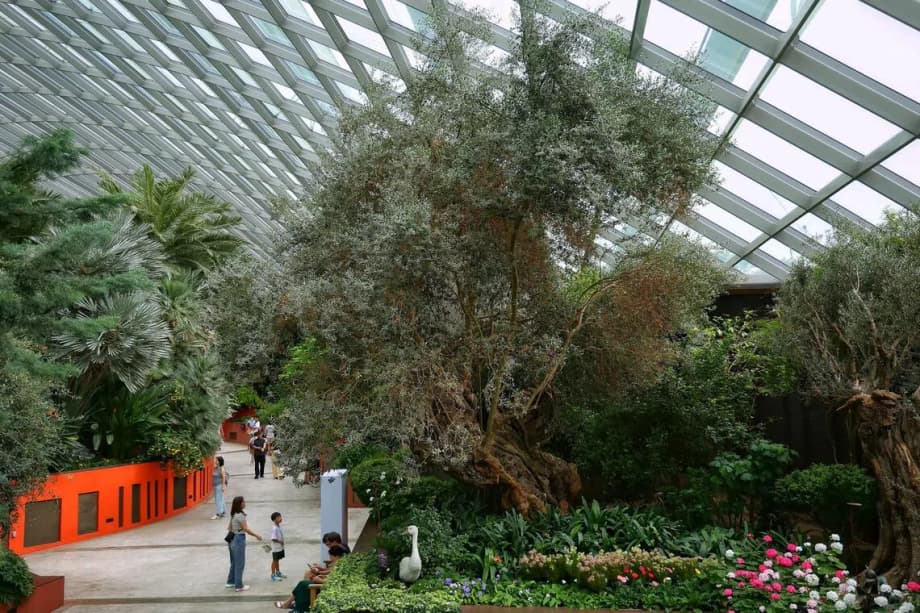Why learning outside the classroom works
When children learn with their hands, eyes, ears, and feet, ideas stick. Education researchers often call this place based learning because it links knowledge to real locations, communities, and ecosystems. Across two decades of published studies, educators report that this approach builds curiosity, problem solving, collaboration, and care for the natural world. Lessons delivered in context, such as a garden, museum, or shoreline, help children connect what they read or hear to what they see and do. Families can support this by turning weekends and holidays into gentle learning journeys.
- Why learning outside the classroom works
- How to turn a day out into a learning adventure
- Flower Dome’s ancient olive tree
- The five dollar Tembusu at Botanic Gardens
- A pink axolotl with a message at Singapore Oceanarium
- Sembawang Hot Spring Park’s living science lab
- A vegetable farm on a Tampines carpark roof
- More places that blend fun and learning
- Planning tips, access, and costs
- At a Glance
Many schools also use outdoor and community venues as extensions of the classroom. During the pandemic, teachers everywhere looked for safe ways to keep students engaged, and interest in learning beyond four walls grew. There are challenges, such as time and coordination, yet families play a vital role. A short visit to a nearby park, a gallery studio, or a science exhibit can complement school topics in science, language, or art with fresh purpose.
In Singapore, educators across museums, preschools, and science centers describe consistent benefits when children take part, reflect, and explain what they notice. Tinkering in a science studio, sketching a single artwork before making their own, or observing how plants adapt in tropical heat all help children develop confidence, patience, and empathy. The five spots below show how a simple outing can become a rich investigation.
How to turn a day out into a learning adventure
Start with curiosity. At home, set up a simple idea wall with sticky notes where children can write questions they would like to explore. Before an outing, ask them to predict what they might see. During the visit, invite them to lead. Use open prompts such as What do you notice, What changed since we arrived, and What else could explain this. Keep questions short and allow lots of time for unstructured exploration.
Pack a small notebook, pencils, and a phone for photos or voice notes. Agree on one challenge, for example find three textures in a garden or spot two patterns in an exhibit. After the visit, ask your child to draw what surprised them and share one new question. These small routines turn a fun day out into a habit of observing, reasoning, and talking about evidence.
Flower Dome’s ancient olive tree
Inside the Flower Dome at Gardens by the Bay stands a remarkable survivor, an olive tree that is about 1,000 years old. The tree was brought from Spain in 2011 and is the oldest specimen in the conservatory. Children can look for the other olive trees in the dome to compare trunk shapes and leaf patterns. Horticulture staff care for this ancient plant with frequent inspections and pruning, a useful reminder that long lived organisms still need careful support in a new climate.
This visit opens a window into plant biology and geography. Talk about where olives grow and what a Mediterranean climate feels like. Look closely at the small, silvery leaves. Their color and texture help reduce water loss in hot, dry regions. Ask your child to imagine how different this tree’s early life would have been in Spain. Remind children to respect any barriers and not to touch living exhibits so the tree stays healthy for future visitors.
Conversation starters
- If this tree could talk, what stories might it tell about water, sun, and seasons
- How do the Flower Dome’s cool, dry conditions compare with the climate outside
- Where do olives in our kitchen come from, and what parts of the plant do people use
The five dollar Tembusu at Botanic Gardens
On Lawn E near Swan Lake in Singapore Botanic Gardens grows a Tembusu that many residents know from the five dollar note. This heritage tree is at least 166 years old and is protected by a fence so its roots and low branches are not harmed by climbing or crowds. The tree’s rugged bark, spreading canopy, and strong lateral branches make it a living landmark for sketching and close observation. The Botanic Gardens is also a UNESCO World Heritage Site, which sets the scene for conversations about conservation and cultural memory.
Bring paper and pencils for a simple draw what you see exercise. Children can compare the note’s artwork to the real tree, then list similarities and differences. The Tembusu produces small cream flowers and fruit, which add to the sensory experience. A calm walk around the lawn helps children notice how much space a mature tree needs and why fences protect roots from compaction.
What to try
- Map the tree from four directions, then describe how light changes the color of the bark
- Count and compare leaf shapes that have fallen on the ground, then group them by size
- Discuss why the fence is there and how many visitors a day the tree might host if unprotected
A pink axolotl with a message at Singapore Oceanarium
In the Conquering Land zone, children come face to face with a pink axolotl. This salamander is famous on games and social media, which makes it a useful bridge to science and ethics. Axolotls are critically endangered in the wild. Habitat loss in Mexico City’s lakes, invasive species, and the illegal pet trade have pushed wild populations to a fragile level. The Oceanarium’s axolotls were rescued from the pet trade, and the exhibit urges visitors to think about responsible pet choices and the harm caused when demand drives wildlife trafficking.
Axolotls are neotenic, which means they keep juvenile features as adults such as external gills and a finned tail, and they live in cool, still waters. Ask your child to identify those gills and compare them to a fish’s gills. Talk about how water quality, temperature, and shelter shape animal design. The exhibit can also prompt a broader discussion: How do personal choices, such as buying exotic pets or products made from wildlife, affect faraway ecosystems. That connection builds moral reasoning as well as scientific knowledge.
Sembawang Hot Spring Park’s living science lab
Singapore’s only natural hot spring park was discovered in 1908. At Sembawang, groundwater rises at about 70 degrees Celsius and flows through a cascading foot bath. Families often cook eggs in the designated areas, a simple test of how heat changes matter. Educational signs explain the site’s history and geology. Unlike volcanic hot spots, these waters are warmed by the normal geothermal gradient underground, then rise through cracks in the rock.
Use the visit to practise safe inquiry. Bring a kitchen thermometer, if allowed, to measure water in the cooler channels and compare it with tap water in your bottle. Ask children to predict cooking times for eggs at different points along the flow. Discuss energy transfer and why we never touch the source water. Compare steam and liquid water, and notice how quickly heat escapes on a windy day.
A vegetable farm on a Tampines carpark roof
On top of a Housing Board carpark in Tampines, Nature’s International Commodity runs a 2,500 square meter vegetable farm. Members can harvest produce during scheduled sessions, and the farm hosts educational tours that show how seeds become salads. A bilingual picture book inspired by the project helps younger children connect food in the kitchen to beds and trellises on the roof. This is urban agriculture in action, a practical way to discuss land use in a compact city and why local food matters for resilience.
Hand children a tape measure to track plant growth, or ask them to estimate harvest weight by comparing bunches on a scale. Look for composting or pest management methods, then talk about why farmers aim to work with, not against, nature. The rooftop setting is also a gentle reminder that a city can grow food in unexpected places, from balconies to community plots.
More places that blend fun and learning
These additional venues around the island also turn play into discovery. They suit different ages and interests, and many cost little or nothing.
- Science Centre Singapore and KidsSTOP: Build and test ideas in the Tinkering Studio, try hands on exhibits that explain motion, electricity, and sound, and explore zones designed for early learners.
- National Gallery Singapore’s Keppel Centre for Art Education: Touch friendly installations and creative studios invite children to make, observe, and talk about art in a structured yet playful way.
- Jacob Ballas Children’s Garden: A garden designed for kids with treehouses, a farm zone, and water play that make botany and ecology easy to grasp.
- NEWater Visitor Centre: Free guided tours explain how Singapore cleans and recycles water, with interactive activities that connect daily habits to water security.
- Kranji farms: Meet goats, stroll through vegetable plots, and talk with farmers about soil, pollinators, and local produce.
- Singapore City Gallery: An inside look at how planners design neighbourhoods, transport, and parks, with a detailed city model and interactive displays.
- Central Public Library’s Children’s Biodiversity Library: Books, exhibits, and activities centred on Singapore wildlife and habitats encourage reading and inquiry.
- Role play cities such as KidZania in other countries show how children learn about work and money through play. In Singapore, children can find similar experiences by combining a visit to the Children’s Museum with science and art studios.
- Jurong Play Grounds: A large family hub where children can move, climb, and explore themed zones. With a little framing by parents, activities here can spark talk about simple machines, balance, and teamwork.
Planning tips, access, and costs
Some of the locations above are free to enter. Singapore Botanic Gardens, Sembawang Hot Spring Park, Jacob Ballas Children’s Garden, and Singapore City Gallery do not charge admission. Others require tickets. Flower Dome and Singapore Oceanarium are paid attractions, and rooftop farms often run by membership or tour fees. Check opening hours, booking requirements, and safety notices on official websites before you go.
Travel light and plan for the weather. Early mornings bring cooler air and fewer crowds, which helps young children stay focused. Pack water, sun hats, and a spare change of clothes if play may get wet. Respect all fences and signs, and remind children that animals and heritage trees are not to be touched or climbed. Take no samples from exhibits. At the Oceanarium, explain why we never tap on glass and why rescue and rehabilitation help animals in distress. Small choices like these show children how care for people, places, and living things is part of learning.
At a Glance
- Experiential, place based learning helps children connect ideas to real life and builds curiosity, problem solving, and collaboration.
- Flower Dome hosts a 1,000 year old olive tree from Spain, the oldest in the conservatory, which invites lessons in plant adaptation and care.
- At Singapore Botanic Gardens, the Tembusu on the five dollar note grows on Lawn E near Swan Lake and is protected for its long term health.
- Singapore Oceanarium’s pink axolotls highlight wildlife conservation and why ethical pet choices matter.
- Sembawang Hot Spring Park is a safe setting to explore heat, states of matter, and geothermal processes.
- A Tampines rooftop farm shows how cities can grow food and teaches children where meals begin.
- Science Centre, National Gallery, Jacob Ballas Children’s Garden, and NEWater Visitor Centre offer free or low cost learning options.
- Use an idea wall, open questions, and short reflection routines to turn outings into inquiry without lectures.
- Check hours and bookings, bring water and sun protection, and respect fences and animal welfare rules.




